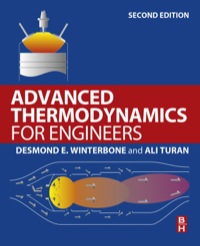Problems P3.2, P3.9 and P3.10 have shown how the efficiency of a basic Rankine cycle can be
Question:
Problems P3.2, P3.9 and P3.10 have shown how the efficiency of a basic Rankine cycle can be improved, but even after superheating the steam leaving the turbine is still wet. This situation could be alleviated by using two turbine stages and reheating the steam between them.
Calculate the basic parameters for the cycle if the steam is withdrawn from the HP turbine at 10 bar and reheated to \(400{ }^{\circ} \mathrm{C}\).
What are the specific power outputs of each turbine?
[32.14\%; 51.40\%; \(1039 \mathrm{~kW} /(\mathrm{kg} / \mathrm{s}) ; 0.925 ; 845 \mathrm{~kW} ; 196 \mathrm{~kW}]\)
P3.10
Both cycles in P3.2 and P3.9 resulted in extremely 'wet' steam (low quality) at the exit to the turbine. This would cause erosion of the blades, and should be avoided. One way of achieving this is to superheat the steam before it leaves the boiler: assuming that the temperature of the steam leaving the superheater is \(400^{\circ} \mathrm{C}\), calculate the same parameters for this cycle using the basic data in P3.9. What is the quality of the steam leaving the turbine?
Also calculate the mean temperatures of energy addition and rejection, and show that a Carnot cycle with these temperatures would have the same efficiency as this Rankine cycle. [31.02\%; 51.40\%; \(937 \mathrm{~kW} /(\mathrm{kg} / \mathrm{s}) ; 0.878 ; 474 \mathrm{~K} ; 326.9 \mathrm{~K}\) ]
P3.9
The condenser pressure of the turbine in P3.2 is reduced to 0.15 bar. Calculate the same parameters for this cycle as in the previous example. Why have the parameters improved so much? [28.97\%; 32.65\%; \(744.8 \mathrm{~kW} /(\mathrm{kg} / \mathrm{s})]\)
P3.2
A steam power plant operating on a basic Rankine cycle has the following parameters: maximum (boiler) pressure 20 bar; minimum (condenser) pressure 0.5 bar. Calculate the thermal efficiency of the cycle, and compare it to that of a Carnot cycle operating between the same temperature limits (see P3.1). Calculate the specific power output and the back work ratio (defined as \(\dot{w}_{\mathrm{P}} / \dot{w}_{\mathrm{T}}\) ) for the cycle in this question and that in P3.1. Comment on the results obtained.
(Assume the pump and turbine operate isentropically.)
[24.26\%;27.0\%;598.5 kW/(kg/s); 0.34\%; 14.7\%]
Step by Step Answer:

Advanced Thermodynamics For Engineers
ISBN: 9780080999838
2nd Edition
Authors: D. E. Winterbone, Ali Turan





